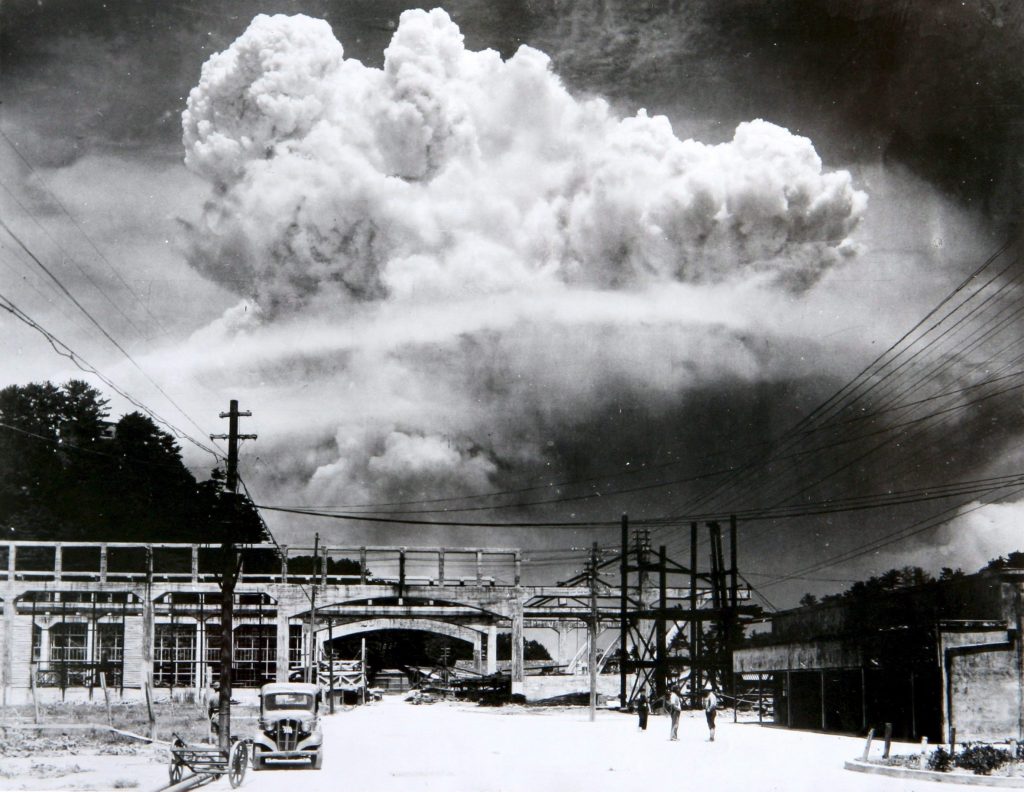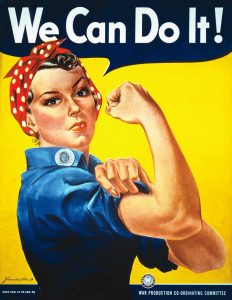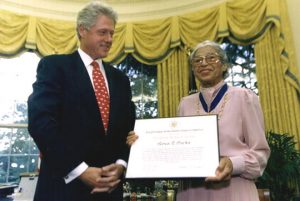August of 1945 marked grim days of apprehension for many cities across Japan. The Japanese people were running dangerously low on resources and manpower to continue the conflict of World War II, while the United States had steadily increased the frequency of air raids on the Japanese mainland islands. In spite of being desperate, the Japanese people couldn’t admit surrender without assurance that their emperor, whom they regarded as a godlike idol, would not be disposed of—a condition that the Americans would not entertain. Meanwhile, the United States public was sour on the idea of sending additional troops into the Pacific for what would surely be a costly land invasion of the Japanese mainland.1 The ongoing aerial raid campaign, which would claim hundreds of thousands of Japanese lives, wounding countless others, and decimating if not entirely leveling cities, would not be enough to provoke an unconditional surrender on behalf of the Japanese people.2 Alas, President Truman, as well as the American people, were in search of resolution to their Pacific conflict. Japan and the whole world alike were aghast as the U.S. unleashed the first ever atomic bombs on the Japanese cities Hiroshima and Nagasaki on the 6th and 8th of August, respectively. But, perhaps, no one would be quite as appalled as Tsutomu Yamaguchi, who would endure and witness both atomic demonstrations.
In early June, Tsutomu was called away from his home in Nagasaki to help oversee the design and manufacture of battleships and fuel transports at a shipyard in Hiroshima. Due to the U.S. naval fleet blockading the region, the Japanese were forced to produce half-sized vessels. It wasn’t until being separated from his wife and 3-year-old son that Tsutomu experienced his first major encounter with the encroaching enemy. While stationed in the Hiroshima shipyard dormitory, he observed the vast and overwhelming hundreds of planes enlisted in the strategic raids against Japan. However, the raid would shy in comparison to what was to come.3
On August 5, the day before Hiroshima was to be bombed, the business objectives at the Mitsubishi Shipyard in Hiroshima were complete; however, damage to Japanese infrastructure back in Nagasaki delayed the young worker’s return. It wasn’t until the following day that Tsutomu was given the go ahead to come back home. On his way to the train station on the edge of town, he realized he had left his travel stamp and ID behind. Forced to return to retrieve those items, Tsutomu headed back to his camp. While passing by a shooting gallery, he heard the faint roar of a distant B-29 bomber. Tsutomu looked to the clouds, but caught no glances of the aircraft. Instead, he saw a slowly falling pair of parachutes. Boom! There was a blinding flash followed by a wave of immense heat. He was hurled into a neighboring potato patch. When he regained consciousness, he found his hair fused into his scalp and severe burns seared along his left arm, upper torso, and face.4 Though many other victims would be encountered throughout Tsutomu’s journey home—baring injuries that varied from burns and abrasions to lacerations and radiation exposure—countless others would die in the infernos and blazes that chained through any remains of the sprawling metropolis. Tsutomu Yamaguchi managed to escape the fallout and evacuate on a train bound for Nagasaki. There he was reunited with his family and received treatment from a generous acquaintance from his past. But he was not in the clear just yet.5

During his business trip, the Japanese began relocating the residents of Nagasaki to the rural outskirts. Strangely enough, Tsutomu and his family were moved to the most dangerous part, just outside the Nagasaki Shipyard. Mere minutes before the second atomic bomb was dropped, with little options at his disposal, Tsutomu reported in for work. His boss called him in to inquire about the events that took place; Tsutomu spoke of a single bomb causing tremendous devastation. During the discussion, a familiar flash pierced their retinas. Yet again, he’d come face to face with the atomic adversary that was wreaking havoc on the Japanese people. But his fight wouldn’t be stopped there.6
He and his family survived the ordeal and after the war, Tsutomu made use of his license to teach English at a junior high school. After ten years of teaching, he returned to Mitsubishi Shipyard and retired. With time, Tsutomu would officially become recognized, by both the United States and Japan, as having survived both atomic bombs, earning him the title “nijū hibakusha” (or twice-bombed man).7 He would go on to use his recognition and experience to advocate for the abolishing of nuclear arsenals. Tsutomu realized that nuclear arms wouldn’t lessen the price humanity pays for its wars; to the contrary, it would merely accelerate and facilitate its own destruction.8

- Henry Lewis Stimson, “The decision to use the atomic bomb,” Harper’s Magazine (February, 1947): 97-107, www.harpers.org/archive/1947/02/ ↵
- Jonathan Rauch, “Firebombs Over Tokyo The Atlantic,” The Atlantic 272, no., 5 (2002): 1-1, https://www.theatlantic.com/magazine/archive/2002/07/firebombs-over-tokyo/302547/. ↵
- Tsutomu Yamaguchi et al., Double A-Bomb Victim: My Life beneath the Atomic Clouds (Nagasaki Prefecture: Department of Political Science, Faculty of Education, Nagasaki University, 2013), 88-90. ↵
- Charles Pellegrind, The Last Train From Hiroshima: The Survivors Look Back (New York: Henry Holt and Company, LLC, 2010), 15-17. ↵
- Twice, directed by Hidetaka Inazuka, 2011, Netflix. www.netflix.com/title/80208212; Tsutomu Yamaguchi et al., Double A-Bomb Victim: My Life beneath the Atomic Clouds (Nagasaki Prefecture: Department of Political Science, Faculty of Education, Nagasaki University, 2013), 93-94. ↵
- Tsutomu Yamaguchi et al., Double A-Bomb Victim: My Life beneath the Atomic Clouds (Nagasaki Prefecture: Department of Political Science, Faculty of Education, Nagasaki University, 2013), 106-107. ↵
- The Associated Press, Survivor of Both A-Bombs Is Certified (Manhattan: New York Times, 2009). ↵
- Tsutomu Yamaguchi et al., Double A-Bomb Victim: My Life beneath the Atomic Clouds (Nagasaki Prefecture: Department of Political Science, Faculty of Education, Nagasaki University, 2013), 110. ↵



31 comments
Ruby Wynn
I enjoyed reading this article. It is amazing to think that one man survived two atomic bombs. I love the descriptions you use in this article. The way you describe the scene and events makes it seem like the reader is there and experiencing the event. The destruction and injuries from the first bomb were described in detail, I cannot help but wonder what happened after the second explosion.
Fatima Navarro
I especially enjoyed the first part of this article, the first set of paragraphs set the article and story. I also found the topic and the story interesting. I got to know a man who survived both bombs and decided to advocate against nuclear arms, which I find eligible for praise. I, on a personal opinion, wish for the state and its people to advocate for denuclearization everywhere, hoping no individual would have to go through something like this before they start advocating for a free nuclear world.
Diamond Davidson
The first paragraph really was strong and effective. I just don’t like how it went straight into what the person was doing at the moment and not giving us background about his life. Then once I got to the middle of the article, there was apart about his family and how he was taken from them, but once that part was mention, we didn’t hear about them anymore. Overall, there were some good parts of the story, but there were other parts that could have been stronger.
Avery Mascorro
This has to be some of the worst luck to ever exist, but at least he and his family survived. I think many have heard of the story of this man who was bombed both times, but never much detail about him. Some redeeming quality of this is that he is an advocate for the abolishing of nuclear arsenals. That is something positive out of the negative affects of nuclear warfare.
Engelbert Madrid
Wow. It’s hard to believe that Tsutomu Yamaguchi survived both atomic bomb attacks. Although Yamaguchi passed away in 2010, his story is incredible because his point of view is important to understand the destruction and the effects of nuclear bombs. Only this man and some people that survive the attacks can only understand the pain of this event in World War II.
Samantha Ruvalcaba
Nothing rings more “wrong place, wrong time” than this article right here. Noting that Tsutomu was recognized by both the United States and Japan as the “nijū hibakusha” in the end also adds an ironic element. As an American, I read this article with a bit of a guilty conscious, even more so with the way that the author illustrated the events and bombings that Tsutomu survived.
Diego Terrazas
What misfortune Tsutomu encountered! Surviving not one but two nuclear bombs is quite the miracle. The use of such weapons showcases how desperate the United States was in ending the war. It is a shame that innocent people got affected by the bombs, but then again war consists of such gruesome acts. I am glad he was able to survive both attacks and advocate against such weapons of mass destruction.
Mariah Garcia
The story of Tsutomu wasn’t a story I had heard before. It is sad that he had to endure the two nuclear bombs and suffer tremendously from the first one. When I read that his hair was fused into his scalp, it gave me chills to even imagine that. Though it is insane that even though that Japan was running low on their resources, they wouldn’t surrender because they wanted their emperor to live and make sure the Americans were not going to kill him. If the Americans had decided to assure Japan that their emperor would not be disposed of, would the bombing of Hiroshima not have happened or would history still be the same?
Christopher Hohman
Nice article. I’m not quite sure if I consider him lucky or unlucky. He survived both bombs which made him lucky but at the same time to have to go through that twice is really something. I like how he used his experience to advocate for nonviolence and nuclear disarmament. That is an issue that is very important in today’s world because nations like the U.S and Russia have the ability to destroy whole entire cities with a push of a button. I do not think that the existence of these weapons helps humanity one bit. It was good of this survivor to speak out against it
Carlos Sanchez
Talk about luck, Tsutomu Yamaguchi is probably the luckiest person ever. For Tsutomu to be at the two locations in history to be struck by the atomic bombs is mind-boggling. I couldn’t even imagine starving the first bomb being dropped at Hiroshima and then being relocated to Nagasaki and then having to endure the second bomb as well. I think the part that makes him lucky is yes not only surviving the bomb but also his family surviving.